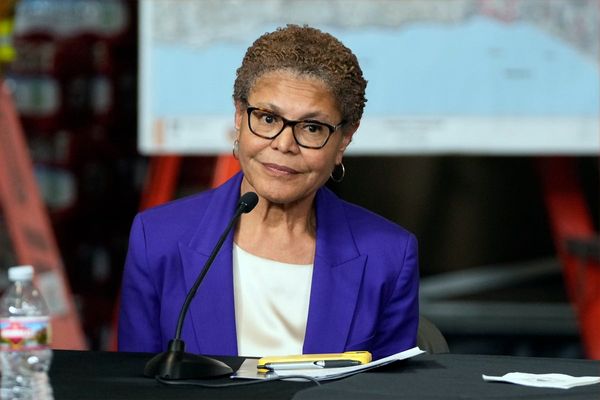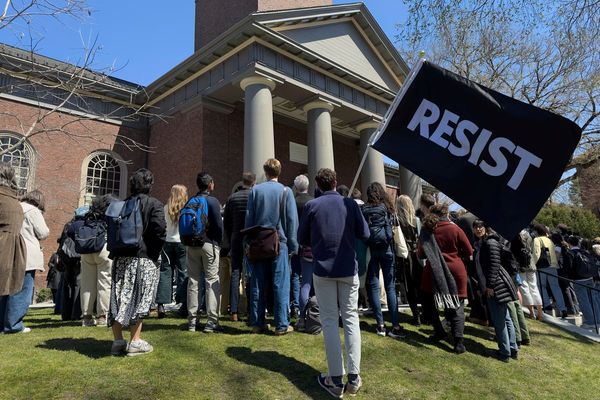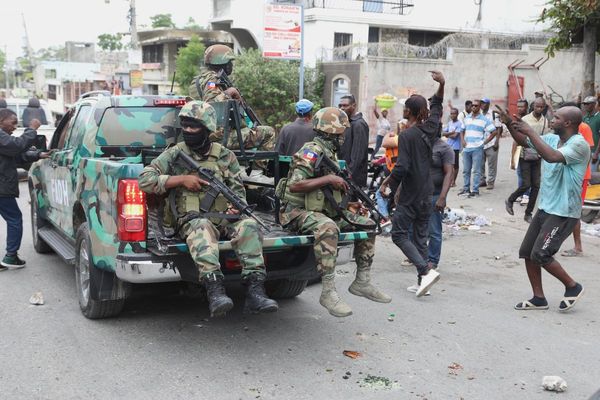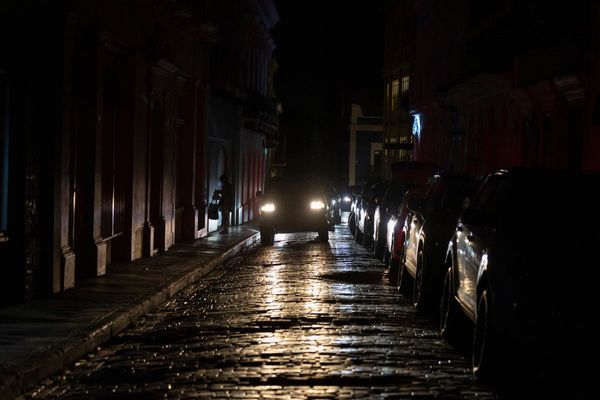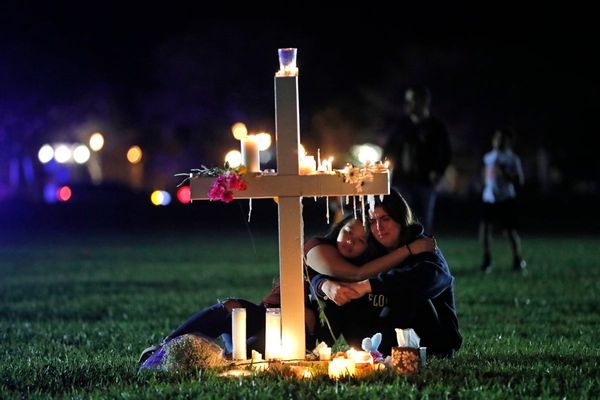
The last time Poornima Ramarao spoke to her son, a 26-year-old software engineer named Suchir Balaji, was on his birthday, Nov. 21. He was on a backpacking trip with a few friends on Catalina Island, right off the coast of Los Angeles. It was a quick call. Ramarao wanted to let him get back to celebrating with his friends. “I blessed him, but my blessing didn’t protect him,” Ramarao tells Fortune.
After Balaji returned the next day, he spoke with his parents one more time—a brief call with his father, who told Fortune his son sounded normal, despite what would soon happen. But after not hearing from Balaji for a few days, Ramarao began to worry. On Nov. 25, she went to his home by San Francisco’s Hayes Valley neighborhood and knocked on the door but didn’t get a response. She still had not heard from him the next day, and decided to go to the police department and file a missing person’s report. When the cops finally gained entrance to his apartment, they brought out Balaji’s body on a stretcher. He had died from a gunshot wound to the head.
San Francisco medical examiners initially ruled Balaji’s death a suicide, although many questions persist for his parents—and for the wider public. That's because Balaji was not just a software developer, but a former researcher at OpenAI who had gone to the New York Times a mere few months before to decry what he viewed as the AI’s company’s illegal copyright violations. At the time of his death, Balaji was prepared to testify as a witness at a landmark lawsuit brought by the newspaper against the artificial intelligence behemoth.
Since Balaji’s death, Ramarao and her husband, Balaji Ramamurthy, have been looking for answers. Ramarao made a January appearance on The Tucker Carlson Show to express concerns about how her son’s case has been handled by authorities. And on Jan. 31, she and Ramamurthy filed a lawsuit against the San Francisco Police Department, demanding it release its full report into their son’s death.
Balaji himself has become a symbol of fears about OpenAI’s creeping power and his death a source of rampant conspiracy theories, spurring online speculation, prodding tweets from Elon Musk and elected officials, and even a memecoin launched by an anonymous figure allegedly raising funds to support the parents’ legal effort.
But beneath the most salacious headlines is the tragic death of an exceptionally gifted programmer and researcher, described by family and friends who spoke with Fortune as a prodigy with a firm moral compass. His parents are still searching for closure.
"We will take this to the public,” Ramarao says. “We will be taking it everywhere. We will even send it to President Trump.”

Who was Suchir Balaji?
Before Balaji left OpenAI last August, he had spent four years among the company’s top researchers, having helped develop its flagship GPT-4 large language model, the underlying technology to the commercial blockbuster ChatGPT. That vantage point helped build his view that OpenAI was breaking the law by making copies of online content.
OpenAI was Balaji’s first job out of college, a prodigious leap that was, for his parents, completely expected. From the time he was little, Ramarao knew her son was exceptionally smart. At two years old, Balaji was already showing an interest in programming. “He would take us to Barnes & Noble and show us the Java book section,” Ramarao recalls.
Balaji grew up in Cupertino, Calif., the heart of Silicon Valley and home of Apple. By 11, he was programming on his own—a skill he used to playfully torment his friends. One remembers Balaji’s idea of a middle-school prank: writing code that deleted a friend’s Skyrim save file. (Skyrim, a popular video game, usually sees its players pour hundreds of hours into their games.)
Before starting at UC Berkeley as an undergrad, Balaji took a gap year to work at the online forum Quora as a software engineer. While other new employees hired out of high school struggled, one coworker who spoke with Fortune says that Balaji fit right in. “He was mature beyond his years,” says the coworker, who spoke on the condition of anonymity to protect their privacy. They remember that Balaji had a knack for reading people at the poker table. “He always took our money,” the coworker says.
Even at the brainy mecca of Berkeley, Balaji stood out. One friend recalls being in a computer science class with him, and in a famously difficult midterm, Balaji got one of the highest scores without studying: "Something insane, like, four standard deviations above the mean,” says the friend, who like most of the acquaintances who spoke with Fortune did so on the condition of anonymity to protect their privacy given the conspiracy theories that have proliferated. “I thought, ‘Who is this guy?’” the friend tells Fortune. "I'm not his intellectual equal by any means."
Balaji was also one of a select few accepted to Berkeley’s Accel Scholars Program, a mentorship program founded by elite Silicon Valley venture capital firm Accel supporting young software engineers looking to pursue careers in tech. "He was a really brilliant, thoughtful person with a lot of confidence and courage,” said Amit Kumar, the Accel partner who founded the program. "In a university full of outliers, he stood out in terms of raw intellectual horsepower… He would have been great at anything he applied himself to."
Balaji was drawn to the frontier technology of artificial intelligence, interning at the rapidly growing startup Scale AI in 2019 while he was in college. One friend who worked with him says Scale seemed to hope he would return. Balaji became drawn to OpenAI, where he’d also interned. Its cofounder, John Schulman, directly recruited Balaji out of college for a full-time job.
Balaji would spend his first four years out of college with OpenAI, helping gather digital data to train the company’s growing neural network. Still, he would later tell the New York Times that he viewed his work as a research project, not as the foundation for OpenAI’s later smash hit, ChatGPT. Over time, three friends tell Fortune that Balaji seemed to become disillusioned slowly, sharing memes to communicate his displeasure with OpenAI’s trajectory. One friend says that Balaji disagreed with OpenAI’s approach to achieving artificial general intelligence, the north star for the AI sector. The friend remembers Balaji complaining that OpenAI, which began as a non-profit lab and has gradually evolved into a commercial enterprise, was too focused on software sales and wasn’t willing to invest enough on the research side. Balaji joked to several friends that AGI, or artificial general intelligence, stood for “adjusted gross income.” They don’t remember Balaji bringing up concerns with OpenAI’s approach to copyright.

When he quit OpenAI, some longtime friends were surprised, while others felt it had been coming. Balaji left in August 2024, the same month that Schulman also made his high-profile exit. All the friends and family that Fortune spoke to said that Balaji’s first few months out of OpenAI were surprisingly normal, as he advised at least one AI startup and rode his Yamaha motorcycle around San Francisco, contemplating what he’d do next.
No one that Fortune spoke to, including his parents, knew of his plans to become a public advocate for what he viewed as egregious legal violations by his former employer.
The whistleblower
Ramarao never expected her son to speak out against OpenAI, especially in such a public way. She had gotten the sense he wasn’t happy with OpenAI at the time he’d left. But when the New York Times article came out, it caught her off-guard.
“He just said, ‘It's unethical, and I feel it's wrong,’” says Ramarao. “‘We need to speak up.’”
In a series of interviews, Balaji told New York Times tech reporter Cade Metz that he believed OpenAI would cause more societal harm than good, making the case that the company was violating copyright laws based on his own intricate understanding of how its models are trained. Metz published his article in October, with Balaji posting a detailed essay on his personal website the same day laying out his case that OpenAI was breaking fair use laws.
Balaji isn’t the first former OpenAI employee to speak out against the company. A group of nine had come forward to the New York Times just a few months before, alleging a culture of recklessness and deteriorating safety protocols, accelerated by the dramatic firing, and immediate return, of cofounder and CEO Sam Altman the year before.
Unlike the other group of OpenAI employees, Balaji wasn’t divulging any previously unknown inside information about the company—a distinction that has caused some to take issue with his classification as a “whistleblower.” And one intellectual property lawyer, who spoke with Fortune on the condition of anonymity because of the conspiracy atmosphere around the death, says Balaji’s own analysis “misunderstands the law in some fundamental ways.” Another, the intellectual property attorney Bradley Hulbert, tells Fortune that Balaji’s post reads like “the argument of a really smart non-lawyer who read up on the subject but does not have a thorough understanding.”
But Balaji’s decision to come forward still served as a potent alarm against OpenAI’s seemingly unstoppable momentum—here was one of its young, phenom engineers helping explain to the public how the technology actually worked and the harms it could cause. The New York Times, which has sued OpenAI alleging unauthorized use of millions of its articles by the company to train its AI models, even named Balaji as a witness in its ongoing lawsuit against OpenAI. Balaji’s testimony, reckons Hulbert, would likely have been used “for color” to help the newspaper make its case to a jury,
Even though Balaji had been secretive about his life-changing decision, people who knew him weren’t surprised. His former coworker at Quora, who hadn’t spoken to Balaji since their time at the company years earlier, remembers following the news. “I always felt he had a good head on his shoulders,” they tell Fortune. “He knew what was right and what was wrong.”
And while it may have seemed impulsive to go to the New York Times without even telling his parents, friends say that Balaji wouldn’t have made the choice without his characteristically methodical consideration.
“He seemed like he was making all these impulsive decisions, but no—they’re impulsive to people who aren’t in the loop or to those he’s not specifically talking about these decisions to,” one close friend who’d previously worked with him said. “I saw him as someone who was very systematic and thoughtful, kind of about everything.”
Balaji had a crew of 10 close friends from high school. They kept an active group chat where they shared memes, and ever since the pandemic, went on two backpacking trips a year together. One friend, who was on the final Catalina trip before Balaji’s death, remembers that they would all joke together about Balaji’s decision to go public.
They were all big fans of Dune and would compare his action to a famous war in the books—a crusade against computers that ends with the elimination of AI in the story’s universe. “Anytime we talked about it, it would be in a joking manner,” says the friend, who spoke on the condition of anonymity to protect their privacy.
Even so, Ramarao knew that her son’s very public revelation would come with consequences. She remembers even thinking that as she looked at his picture, stoic and shrouded in shadows, in the New York Times. “My mother’s instinct was very strong,” says Ramarao. “I really felt something grave was going to happen to my son. And he just kept assuring me: ‘Mom, it’s just my opinion. I haven’t done anything wrong.’”
What happened?
About a month after the New York Times story came out, Balaji was dead. It’s not clear how long Balaji’s body was in the apartment before it was discovered on Nov. 26. From the day she learned of his death, Ramarao had already begun to feel that her son’s case was not being properly investigated.
Her lawyers lay out the case in their lawsuit against the police department, filed on Jan. 31. According to the complaint, a representative from the city’s Office of the Chief Medical Examiner (OCME) informed Ramarao 40 minutes after they found his body that Balaji had died by suicide. The lawsuit alleges that no officer or examiner asked her any questions about her son, even when she informed them he had been a whistleblower against OpenAI. The representative also told her she would not be allowed to see his body, and that his face had been “destroyed” when a bullet went through his eye. The gun was registered to Balaji. He had bought it in January 2024.

A spokesperson for the San Francisco Police Department told Fortune that “no evidence of foul play was found during the initial investigation,” but that the investigation remains open as of Feb. 7. The OCME declined comment.
Harboring doubts, Ramarao decided to hire an independent examiner named Dr. Joseph Cohen, a forensic pathologist, to conduct a private autopsy in the middle of December. According to the lawsuit, Cohen determined that the bullet’s trajectory, which went through his mid-forehead, was “atypical and uncommon” in suicides, also noting a “contusion” to the back of Balaji’s head.
Dr. Cohen did not respond to several requests for comment.
After receiving Cohen’s report in mid-December, Ramarao sent a letter through her lawyers to the police department, OCME, and the San Francisco Office of the City Administrator, asking for a criminal investigation into Balaji’s death, describing it as “troubling.” According to January’s lawsuit, they never received a formal response, but police officials “informally” informed Ramarao’s lawyers that detectives had briefly reopened the investigation to review the building’s closed-circuit recordings and then closed the investigation once again. (The police department told Fortune that the investigation has “remained open since its inception.”) Ramarao’s lawyers have tried to get access to the police incident report, without luck.
According to a person with direct knowledge, who was granted anonymity to discuss nonpublic information, the city’s attorney’s office is going to come out with a a letter soon with detailed facts consistent with a suicide. The OCME and police reports are expected in the same time frame.
In the meantime, Ramarao has become increasingly convinced that her son was murdered. She says that her lawyers directed her to another investigator, Dr. Dinesh Rao, formerly the chief forensic pathologist in the Legal Medicine Unit at Jamaica’s Ministry of National Security. Rao, who spoke to Fortune from India, says that he has not visited Balaji’s apartment. Still, he was able to analyze photos taken from the apartment and sent to him by Ramarao.
In Rao’s 28-page initial report reviewed by Fortune, he raises a number of questions: Was there a suicide note? Did police take fingerprints at the scene? Based on the limited photographic evidence, he also pointed to anomalies, including hair that did not seem to belong to Balaji, as well as blood spatter that did not seem consistent with suicide.
Barring a more complete report from the police, which her lawyers are still demanding, Ramarao has taken her limited evidence on a public awareness campaign. On Dec. 29, she posted on X that Balaji’s death was a “cold blooded [sic] mu*d*r declared by authorities as suicide,” demanding an FBI investigation. The post received nearly 3 million views and a response from Elon Musk. “This doesn’t seem like a suicide,” he replied. (Elon Musk, who was a cofounder of OpenAI but who left in 2018 and now runs a competing company, has a long-standing feud with OpenAI’s Sam Altman over the company’s nonprofit status, and the two often spar on social media.)
The conspiracy flames spread when she appeared on Tucker Carlson’s online show in January, in an hour-plus-long episode. “He believed [that] AI—currently without any regulation—is a harm to humanity,” she tells Carlson. “He stood up for a cause, and he lost his life for a cause. He's a martyr.”
The interview stirred even more outrage, with Rep. Ro Khanna (D-Calif.) echoing her call for an FBI investigation the same day, likely spurred when Carlson sent Khanna a text during the episode. “My heart breaks for Suchir Balaji’s family and his mother, Poornima Ramarao, who I spoke to recently,” Khanna said in a statement shared with Fortune. “She provided me with information that inspired me to speak out. They deserve to have their questions answered.” A spokesperson for Khanna declined to share whether they had additional information about any active investigations. An FBI spokesperson said the bureau cannot confirm or deny the existence of any investigation.
Ramarao told reporters shortly after Balaji's death that she wasn't “pointing fingers” at OpenAI. Since then, her efforts to make sense of the inexplicable tragedy have collided with a teeming online world of conspiracy theories all too eager to latch onto grief and uncertainty. As Ramarao has pushed for answers, a rash of baseless speculation has thrived alongside the proceedings.
When asked for comment, an OpenAI spokesperson forwarded a statement the company posted on X on January 16, which said that it had reached out to the San Francisco Police Department to offer its assistance if needed. “Suchir was a valued member of the team and we are still heartbroken by his passing,” read the post.
A spokesperson for the New York Times declined to comment.

Moving forward
While Ramarao has jumped to extreme conclusions, Balaji’s friends remain uncertain. Balaji’s last days were the backpacking trip to the Catalina Islands with four other friends from his high school crew—a three-night hike on a trail that was a favorite of theirs. Two friends who spoke with Fortune say they didn’t notice anything amiss with Balaji. They didn’t really talk about work, which was normal for them. When OpenAI came up, they made the same jokes about Dune.
Balaji buying a gun earlier in the year also did not seem out of the ordinary, at least according to one friend. Two others in their high school crew also own firearms for recreation and self-defense and they knew that Balaji had one as well, says the friend. But they’re still haunted by countless questions.
"The thing about moving on is that you need to be able to make some sense of the whole situation,” one of the friends tells Fortune. “With this constantly in the news, it's been kind of hard to find that.”
Unlike Ramarao, the two friends say they don’t have an opinion of what happened but still want to see a more thorough investigation. One tells Fortune that they never even got a call from the police asking for additional information.
Still, they say that Balaji did seem to be looking toward the future. They were planning another backpacking trip together, this time to Alaska. At the time of his death, he was working on a new project, likely focused on AGI. It may have been a startup, or a nonprofit. Friends didn’t know specific details, and it’s likely they may never have the full picture.
"My thoughts on the matter are that you can never really tell with these sorts of things,” one friend tells Fortune. “Maybe he was [depressed], maybe he wasn't. I think from all of the times that I've known him, or all of the time that I've known him, there was nothing abnormal about Suchir, until his passing."
Until the police release their final report, which is expected by the end of February, it will be impossible to find any closure. That has not stopped online speculation, which has fed off by Ramarao’s quest for answers, about Balaji’s death—a similar phenomenon to the Boeing whistleblower who was found dead by suicide in March.
Daren Firestone, an attorney who works regularly with whistleblowers, tells Fortune that it is common for them to experience loneliness and doubt. It’s partly why he advises his clients to stay anonymous and go through official channels such as government tip lines. “It creates enormous pressure on somebody and a feeling of isolation,” he says. “And if you’re isolated and you feel the world is against you, that can be challenging for even the most robust minds.”
The last day that Ramarao saw her son was Nov. 7, a couple of weeks before his death. They talked about his career plans and went for a hike together in Union City, Calif., where his parents live. “I still remember his body language,” Ramarao tells Fortune. “He was very proud of what he was doing. There was no fear. I wish he had some fear. He could have survived today.”
